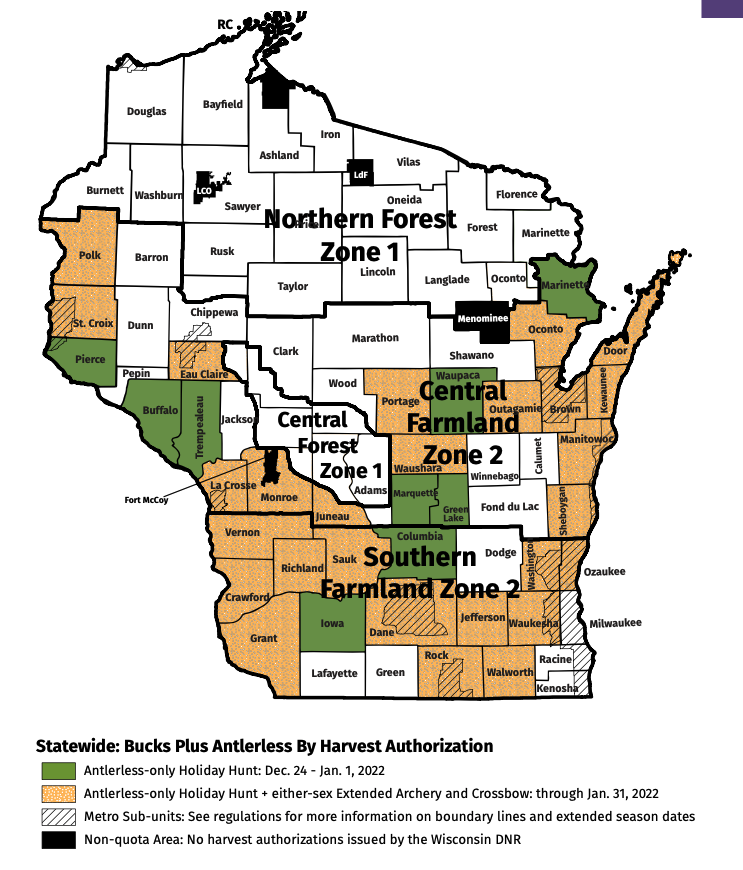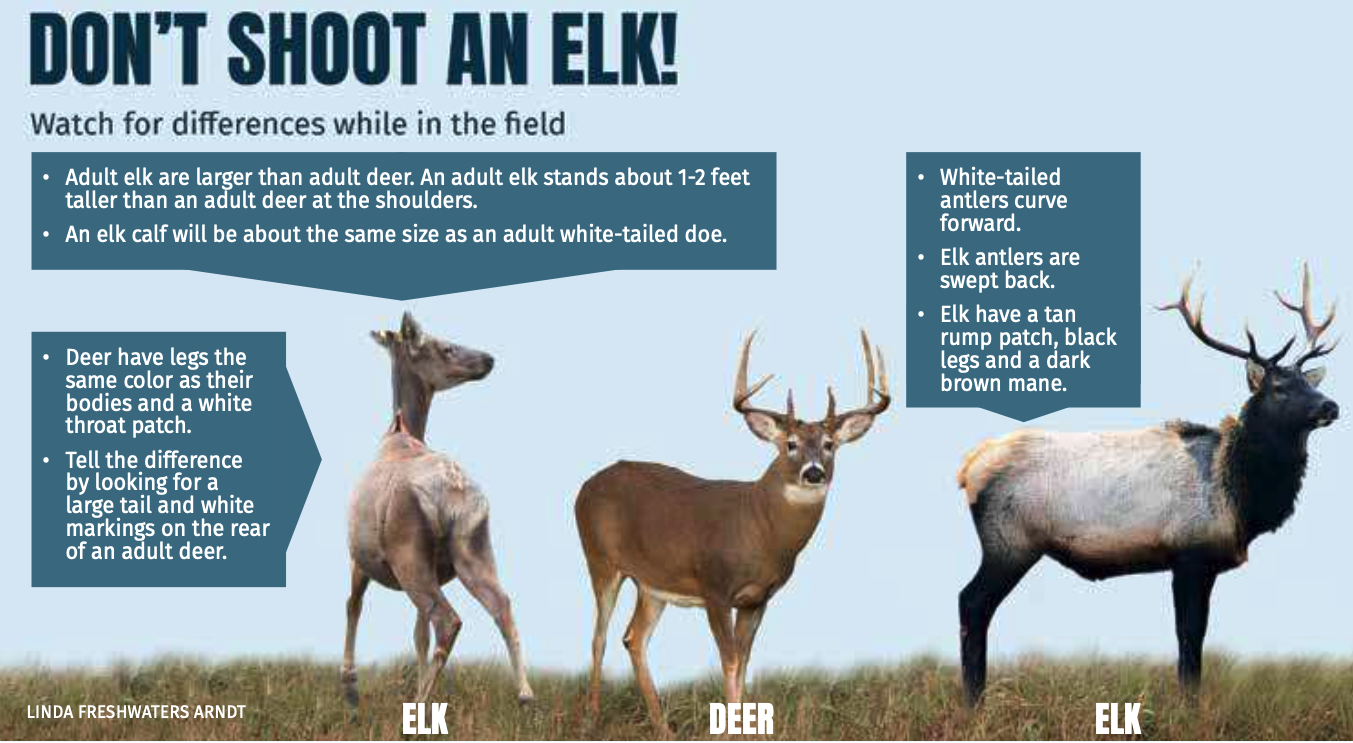
Harvest authorizations are issued with each deer hunting license. The number and types of harvest authorizations issued with a deer hunting license may vary based on where in the state you are hunting. Some harvest authorizations are valid only during certain open seasons or when hunting in certain locations. Each harvest authorization allows the harvest of a single deer of the type specified. The following information outlines the types of harvest authorizations, weapon you may use to fill them, along with where and when they are valid.
Gun Buck Deer Harvest Authorization•
Bow Buck Deer Harvest Authorization
Junior Antlerless Deer Harvest Authorization
Farmland (Zone 2) Antlerless Deer Harvest Authorization
Bonus Antlerless Deer Harvest Authorizations
Metro Sub-unit Antlerless Deer HarvestAuthorizations

DEER CARCASS TRANSPORTATION REGULATIONS
Visit dnr.wi.gov, and search “carcass movement” for the most current carcass transportation restrictions. It is illegal to transport whole wild deer carcasses and parts of such carcasses that were harvested in CWD-affected counties outside of those counties, except those deer carcasses and parts may be transported to a county that is adjacent to the CWD-affected counties, or to licensed taxidermist or licensed meat processor if the delivery occurs within 72 hours of the deer being registered. The following may also be transported without restriction:
A processor or taxidermist who receives a deer carcass must be informed that the deer was harvested within the CWD-affected area.
Many states and provinces restrict the importation of cervid carcasses and hunters should check the regulations of their home state or province, the state or province in which they will be hunting, and the states or provinces through which they will be traveling. For more information, please visit the CWD Alliance website at: www.cwd-info.org.
Quartering Your Deer
Hunters may divide a deer into as many as five pieces to facilitate removal of the carcass from the field, but the head must remain attached to one of the five parts of the carcass. The hide and lower legs, if removed, do not count as one of the five parts. Only one deer that has been quartered may be stored or transported at a time prior to registration, but quartered deer can be transported with other intact deer. The lower legs up to the tarsus joint (ankle or hock) on the hind legs and up to the carpus joint (wrist or knee) on the front legs may also be removed. All parts of the deer, except the entrails, must be removed from the field.Deer must be kept intact while afield, except for field dressing, skinning and quartering.
Scents
Scents which are used only to attract deer by odor may be used for hunting deer statewide, but the scent may not be placed or deposited in a manner that makes it accessible for consumption by deer. Scents shall be removed daily at the end of shooting hours, except two ounces or less of scent do not need to be removed daily and may be placed, used or deposited in any manner for hunting deer.
Natural Vegetation and Plantings
Hunting with the aid of material deposited by natural vegetation, material found solely as a result of normal agricultural or gardening practices, or with the aid of crops planted and left standing as wildlife food plots is legal. It is illegal to establish or maintain food plots/plantings on DNR-owned or -managed lands.
Baiting
It is illegal to place, use or hunt deer over bait or feed material in certain counties. Visit dnr.wi.gov and search “baiting and feeding” for a map of prohibited locations. For the remainder of the state, baiting for hunting purposes is allowed only under the following conditions:
Baiting Amount
On each contiguous parcel of land under the same ownership, up to 2 gallons of bait may be placed in total if the parcel is less than 40 acres. If the parcel is 40 acres or more, 2 gallons may be placed per every 40 acres. Bait may be spread out or divided into more than one pile as long as the total amount of bait or feed material is not more than two gallons per 40 acres.
Bait Placement It is illegal to:
Timing It is illegal to:
Note: Removal of unlawfully placed bait or feed material does not preclude the issuance of a citation for the original placement of unlawful baiting or feeding material.
Register your deer through GameReg by 5 p.m. the day after recovery. All registration is electronic.
Have your deer harvest authorization number available to enter at the start of the registration process.
You will receive a 10-character confirmation number for your records once your deer has been successfully registered. For white-tailed deer, all confirmation numbers begin with “W” and are issued in the format W12-345-6789.
Learn more about GameReg at dnr.wi.gov, and search “GameReg.”
It is illegal to:
Place, use or hunt over any bait or feed material that:
ROUP HUNTING LAW
It is illegal to kill game for another person except during a firearm deer season when a member of a group deer hunting party may kill a deer for another member of the party. However, junior antlerless deer harvest authorizations issued to those age 17 and under may only be filled by the person to whom the authorizations are issued. Group hunting is not legal for persons hunting with bows and crossbows. All participants must be licensed and each must possess a firearm. Members of a group deer hunting party should also agree in advance that a harvest authorization holder is willing to use their authorization number to register a deer killed by another member of the party.
It is illegal to:
Note: Deer with antlers in velvet or in spotted coat may be harvested during the open deer season. The velvet antlers and spotted hide may not be sold or transferred to another person. Albino and all-white deer may not be harvested.
Youth Gun Deer Hunt
Gun Deer Hunt for Hunters with DisabilitiesSpecial gun deer hunting opportunities on sponsored properties are available to hunters with disabilities who hold a Class A, C or D disabled permit or holders of a Class B permit that is issued for longer than one year and which authorizes hunting or shooting from a stationary vehicle. A gun deer license and a sponsor are required.

Gun Deer Hunt for Hunters with Disabilities
Any hunter who harvests a deer that tests positive for CWD during a regular season will be issued a replacement deer harvest au-thorization through the hunter’s Go Wild account. The harvest authorization will be valid for the remainder of the current hunting season as well as the following hunting season.
REDUCE THE SPREAD
Chronic Wasting Disease is always a fatal disease that affects the nervous system of deer, elk and moose. The disease is caused by an abnormal protein called a prion. CWD prions are extremely resistant in the environment and transmission of this disease can occur indirectly through contaminated environments. To learn how you can help to reduce the risk of CWD transmission, visit dnr.wi.gov and search “CWD.”
VENISON: WHAT HUNTERS SHOULD KNOW
Prions concentrate in certain tissues, such as the brain, spinal cord, lymph nodes and spleen, and are present in lower concentrations in other tissues such as muscle. Prions can also survive cooking temperatures. The U.S. Centers for Disease Control and Prevention state that to date, there have been no reported cases of CWD infection in people. However, in the interest of safety, the CDC advises that hunters not consume meat from deer, elk or moose which test positive for CWD.
In keeping with this recommendation, the Wisconsin Department of Public Health recommends that venison from deer harvested in CWD-affected areas not be consumed or distributed to others until test results indicate CWD was not detected in the deer.
If you have your deer or elk commercially processed, consider asking that your animal be processed individually to avoid mixing meat from multiple animals. Venison from multiple deer should be kept separate and labeled before freezing. For more information on human prion disease, call the Wisconsin Department of Health Services at 608-267-9003.
For recommendations on the safe handling of deer, visit dnr.wi.gov, and search “carcass movement.”
Save time by using the online CWD form. A link to the form can be found in your registration confirmation email or in your Go Wild harvest history.
To find a map of carcass disposal and CWD sampling locations visit dnr.wi.gov and search “CWD sampling.”
The Wisconsin DNR’s Hunt Wild App includes maps with carcass disposal and CWD sampling locations, along with public lands maps, online regulation, access to GameReg and shooting hours tailored to your location. Download it today by visiting dnr.wi.gov, and search “Hunt App.”
Check the CWD test result of your harvested deer online! Log into your GoWild account and navigate to your harvest history or go todnr.wi.gov, and search “CWD results.” USE GOWILD TO SUBMIT YOUR CWD SAMPLING DATA ONLINESave time by using the online CWD form. A link to the form can be found in your registration confirmation email or in your Go Wild harvest history.